Interiors are the New Black
THE INTERSECTION OF FASHION AND DESIGN
“As with the creation of beautiful clothes, architecture and decoration have to do with enhancement of the human figure, in that they involve the creation of beautiful settings against which that figure is seen. Such settings affect our spirits and affect how others regard us. And as with fashion, decoration involves fantasy, but with the rules of discipline and propriety more tightly reined.” — Theodore Dell
Known for their “status symbol” shearling, husband-and-wife duo Bessie and Oliver Corral founded the fashion label Arjé in 2016, and by 2020 it was being carried by every major retailer from Selfridge’s to Matchesfashion and Net-A-Porter. Then, when the first wave of Covid hit, followed by a succession of subsequent lockdowns, retailers in their droves began cancelling orders; with everyone stuck at home, there was, perhaps unsurprisingly, little or no demand for $3,000 jackets and coats. Despite having no interior design training, the couple took the somewhat unusual decision to liquidate their clothing line and pivot into selling homewares. As such, they channelled their frustration into gut-renovating the one-bed duplex that had previously served as their studio and living space. The resultant, neutrally hued interiors, a melange of Venetian plaster and fluted oak panelling, inspired — just as one might expect of an inner city Manhattan apartment — by “the south of Spain and Mallorca specifically”, act as a backdrop to their growing collection of furniture and accessories; including the shearling upholstered “Enzo” armchair (the perfect foil, presumably, for all those unused pelts) and sculptural “Cosmo” coffee table (symbolising mind, body, and spirit, or, as duo describe, “the essence of Arjé”) as well as a panoply of artisan-made accessories. The Corrals essentially tapped into a trend that’s been gaining momentum even pre-pandemic, that being an increasing aesthetic obsession, whereby items of furniture, say a chair or throw are becoming as covetable and in demand as “It” bags. Ergo, an increasing number of high-profile fashion houses are turning their hand to homewares, and similarly, we’re seeing creatives who made their names on the catwalk, indulging their love of crafts. Since stepping down as chief creative officer of Diane von Furstenberg in 2017, New-York based Scottish designer Jonathan Saunders (b. 1977) has since gone on to launch a collection of home accessories, including fringed suede pillows and knitted throws, as well as furniture pieces inspired by traditional Japanese architecture. “I like the idea of those lines between fashion and interiors being blurred,” Saunders explains. “There’s an element of self-expression in how you put garments together. And of course, your home is also a canvas.” This might perhaps seem a somewhat more logical transition than that of the Corrals, as despite working for many years as a fashion designer, Saunders trained first in product design and furniture making, thus, to a large extent, in terms of career trajectory, he has simply come full circle. Echoing the designers’ interest in Colour Theory, as espoused by the Bauhaus School of design (a process-led ideology that studies the changing path of colour tones via applied gradients), geometric, simple forms and a focus on discordant colour combinations, employing Saunders’ signature free-pouring and screen printing techniques, are at the core of the range. The antithesis of disposable fast fashion, each piece is made to order, which in theory, makes it inherently less trend-driven and transient than those items of mass-produced homeware akin to “hats, gloves and shoes” (of which, according to fictional Ella fashion director Patsy Stone (b. 19(??)), one can never have too many), seldom thought of as heirloom items, and for that reason, discarded without thought or feeling.
“Flood” chair in neutral, by New-York based Scottish designer Jonathan Saunders, indicative of the growing trend for fashion brands to expand into homewares © Saunders Studio
Hotel d’Orrouer, Paris, the home of Hubert de Givenchy, in the petit salon Picasso’s “Faun With a Spear” (1947) hangs over an antique console © Christie’s images limited, François Halard
Pandemic-induced “nesting” proved a lifeline for many independent fashion labels, with cashmere blankets from Erdem and JW Anderson becoming “must-have” home accessories (and with any hope, supplanting the Hermès “Avalon”, whose monogrammed motif can cheapen almost any room). This obsession with interiors can, at least in part, be attributed to the popularity of social media platforms such as Instagram and TikTok, as, whilst everyone was stuck at home, their main avenues of social interaction transitioned online, and as such, we saw more of people’s interiors than ever before, which in turn, cast a spotlight on home furnishings. As the world opened up post lockdown, “SuperSalone”, the 2021 edition of the design fair Salone del Mobile (effectively a trial run prior to the full-force edition in 2022), had a distinctly fashion-centric feeling, with an uptick in the number of labels taking part, including everyone from Off-White to Bulgari, Fendi and Gucci. Louis Vuitton, whose previous art-world collaborations have included the god-awful Jeff Koons (b. 1955) “Masters” collection — resulting in “Mona Lisa print” handbags straight out of a museum gift shop — presented an evocative collection of homeware, including the “Aguacate” modular room divider by Humberto (b. 1953) and Fernando Campana (1961-2022), made of colourful avocado-shaped pieces and a Raw-Edges table inspired by the night sky. Never knowingly outdone, Dior took over the newly refurbished eighteenth-century Palazzo Citterio to unveil its Médaillon Chair project, which saw seventeen architects and designers, including India Mahdavi, Dimorestudio, Joy de Rohan Chabot, and Khaled El Mays, reinterpret the Louis XVI–style seats once used by founder Christian Dior (1905-1957) in his Paris haute couture salon. Somewhat less groundbreaking, Loro Piana, another brand to jump on the interiors bandwagon, presented a 1960’s “Bul-Bo” floor lamp by Italian architects Roberto Gabetti (1925-2000) and Aimaro Isola (b. 1928), whose bulbous black leather base was inexplicably clad in cashmere. Last year, quelle surprise, as the Milanese fair made a flashy return to sun-soaked streets of Brera, a glut of key fashion players were once again keen to cash in on the ever-increasing popularity of interior accoutrement. Italian powerhouse Prada, one of the few brands bucking the trend, eschewed limited-edition releases, instead hosting a multidisciplinary symposium entitled “Prada Frames”, curated by design studio FormaFantasma, which explored the complex relationship between the natural environment and design. Similarly, Loewe creative director Jonathan Anderson (b. 1984) chose to highlight the way in which broken or damaged objects can be reinvigorated by means of “a craft intervention”. Inspired by the idea of Japanese “kintsugi”, which amplifies the beauty and showcases the history of repaired objects, Anderson tasked artisans Idoia Cuesta, Belén Martínez, Santiago Besteiro and Juan Manuel Marcilla with resuscitating a series of worse-for-wear baskets using the ancient Galician technique of Coroza.
An apartment in Paris, designed by French architect Joseph Dirand, where in the primary suite an acrylic by Jannis Kounellis hangs over the bed, beside an Alighiero Boetti sculpture, photograph by Martin Morrell © Joseph Dirand
As furniture becomes more and more covetable, and ergo “fashionable”, the high street is keeping pace, producing homewares and accessories for an aspirational customer base increasingly keen on getting the look for less. Twentieth-century modernist Pierre Jeanneret (1896-1967) is still the designer du jour for the fashion set, with everyone from Kourtney Kardashian (b. 1979) to Rosie Huntington-Whiteley (b. 1987) seen sprawling across the Franco-Swiss architect’s utopian-inspired cane-back creations; resulting, inevitably, in numerous fakes and “in the style of” approximations, cashing in on the trend for all things Chandigarh — as can be seen for example with the Soho House Hayward dining chair, which effectively bastardises Jeanneret’s now iconic V-leg “Easy armchair” (c. 1955), ruining the simplicity and purity of the original design by padding out the arms and seat cushion. Charlotte Perriand (1903-1999) is another whose work is frequently butchered and reproduced by those designers looking to make a quick buck from her “Nuage” shelving unit (1940) and “Forme Libre” dining table (1938). Of course, some works are less obvious than others, straddling as it were, the fine line between reinterpretation and plagiarism; such as artistes décorateur Jean Royère’s (1902-1981) whimsical, and immediately identifiable, “Quilles” table, with legs in the shape of bowling pins, which in recent years found itself reincarnated as a highly popular and distinctly “en vogue” plush upholstered dining chair. This is not only a problem with fast fashion high-street brands, as anyone with even basic knowledge of design will see there are numerous respected, high-end makers equally guilty of ripping off the work of twentieth-century greats. That said, trophy interior pieces are not only antique or vintage and rapidly include works by contemporary designers such as Charles Zana, Studioparisien, Emmanuelle Simon (b. 1988) and Leo Sentou (b. 1983).
In turn, those such as Christian Liaigre (1943-2020), Joseph Dirand (b. 1974) and Pierre Yovanovitch (b. 1965) have become so fashionable, and ergo synonymous with original, inspired design, that their immediately identifiable “paw”, as the French put it, has been appropriated by myriad pretenders hoping to bluff their way into career-boosting editorials, or, simply as a means of appealing to those who can’t afford the real deal (that said, there’s always a struggle changing the minds of those clients who come ready with a phone full of mood imagery, and a set idea of something they’ve already seen in print). Arguably, this is all a result of trend-driven media, leaving a receptive public salivating not only for the latest pair of sunglasses but for cushions, sofas and lamps, all so as to “fit in” and give the impression of being “on trend”. The result, sadly, is that due to overexposure, those original designers and makers become less and less interesting to those who appreciate the product and not merely the brand name. By no means does it lessen their position within the canon of design, and galleries like Laffanour, Jacques Lacoste and Carpenters Workshop et al won’t stop selling such works, and nor should they, but, in respect of contemporary interiors, it risks bringing designers into the realm of the fashion world, where to capture the public’s imagination, they need to constantly reinvent and reimagine, resulting in an industry increasingly at odds with the idea of original, craft-driven design.
With the upsurge in lifestyle-related Instagram accounts, consumers are being introduced to otherwise unseen homes, be they historical or contemporary, which, in turn, opens their eyes to different eras, epochs and cultures, thus serving to demystify and democratise the interiors sector. Through this seismic shift in knowledge people en masse have a greater awareness and understanding of design, and with that, comes the desire to publicise their own self-professed “good taste” through creating online “content”. As such, social media has made society more competitive as regards to, not only our homes, but the places we go on holiday, and consequently, the hotels we stay in and restaurants and bars we go to, all of which are seen as a cultural litmus test, so as to show we’re living life to the max, with our finger on the pulse of the aesthetic zeitgeist. To all of this, there is, clearly, an element of showing off, perhaps best demonstrated by the insufferable hashtag #ifyouknowyouknow. As a by-product of this ingrained “cool kid” mentality, drilled into us from childhood by an advertising industry keen to exploit insecurities, there’s now a certain kudos not only in terms of how far-flung or obscure the place you’ve travelled but in the nicheness of your coffee table. Whilst your home should, ideally, speak of who you are, apropos your interests, experiences and passions, whether that be travel, art or music, increasingly, the prevailing aesthetic simply reads as smug, in the sense that its an amalgamation of everything the occupants feel they “should” have in their homes, rather than that which actually speaks to them. This banal attitude to decorating that was once, predominantly, class-based — for example, fixed loo roll holders, liquid soap and fish knives all thought of, in Nancy Mitford (1933-1958) terms, as being distinctly “non-U” — has now, typically, become trend-driven.
Dior’s Louis XVI–style Médaillon chair, in polished aluminium, as reinterpreted by minimally inclined French industrial designer Philippe Starck (b. 1949) for the 2002 edition of Salone del Mobile © Dior
Much like fashion, there are tribes, whose interior choices are driven by an amalgam of factors such as education, nationality, social climbing and often, snobbery, be it inverse or otherwise, all of whom think their inherent “good taste” is superior. Essentially those sitting at home in Chelsea on their Soane Britain sofa, with row upon row of Robert Kime cushions are, quite frankly, being judged by those with a coffee table full of Roger Herman ceramics and a vintage Jacques Grange (b. 1944) pumpkin poof (not to mention the rarified few whose capacious entrance hall consists of nothing more than eighty square metres of poured, polished concrete, a Turrell (b. 1943) light installation and an eighteenth-century Venetian chandelier). To draw an analogy with fashion, with respect to interiors, often those seen as particularly chic and stylish don’t wear the same designer head-to-toe, or, for that matter, fall for every new catwalk “trend”, regardless of whether it suits them; rather, they know their mind and feel confident in expressing their true selves and not merely what society has deemed correct. It’s no coincidence that those who lead the pack, couturiers such as Hubert de Givenchy (1927-2018), Roger Vivier (1907-1998), Karl Lagerfeld (1933-2019), Yves Saint Laurent (1936-2008) and Gabrielle “Coco” Chanel (1873-1971), to name but a few, are known as much for their interiors as they are for their fashion, both of which are a reflection of their own inherent, original and enduring sense of style.
Generally speaking, an item of furniture such as a chair or table, has far greater longevity than a coat or bag (the latter of which, in terms of high fashion, can command similar prices), and so by all means, if the tide is turning in favour of society, as a whole, channelling a greater proportion of disposable income into their homes, it can only be a good thing, chiming neatly with an increasing awareness of mindful consumerism and sustainability in general. That said, there’s a very real risk that interiors are becoming the latest fast fashion, with trend-driven glossies fueling the flames of rampant consumerism, encouraging us to embrace the latest colour, print or pattern, resulting in high-street chains such as Oliver Bonas, Zara and H&M home stepping up to fill the void for demand. Whilst there’s a valid argument for making good design available to the masses (something Modernism, sadly failed to implement), that doesn’t equate to cheaply-made furnishings and accessories, designed to be thrown away each season, to be replaced by the latest palm print or Pantone shade. There should be a far greater emphasis, across the length and breadth of the interiors sector, on pushing boundaries and focusing on quality and originality over cheap, fleeting thrills, or else we risk a bland, uninspired monoculture whereby every up-and-coming designer strives for nothing more than aping that which has gone before them.



